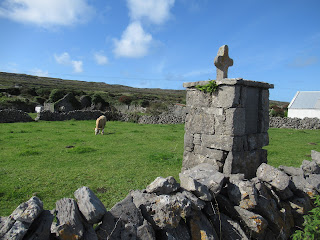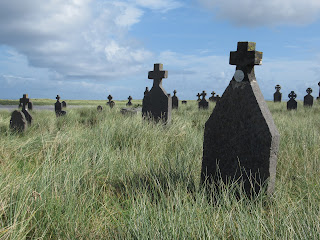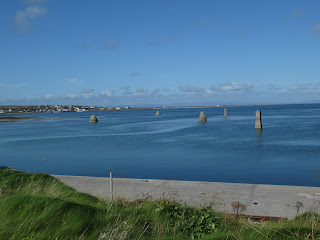From Galway where we'd spent the previous two nights, we drove about 90 minutes to the harbor in Rossaveal to catch the ferry to Inishmore, the largest of the three Aran Islands off Ireland's jagged west coast. Inish, by the way, is Irish for island.
Whenever we're on a ferry, we always love to walk around the boat to take photos but I couldn't remember ever being on a ferry that was as jam-packed as this one was. There was just wall to wall people enjoying the upper deck and the lovely warm weather.
Shortly after I took these photos, passengers stood directly behind and beside our seats so it was virtually impossible to get up and move around. Luckily, the ride was only 45 minutes long so we didn't feel hemmed in for long.
The harbor at Kilronan, the main town on Inishmore:
Inishmore and the other Aran Islands are a Gaeltacht area which means the primary language is Irish but the residents speak English to their visitors. The 800 people of Inishmore welcome as many as 2,000 tourists a day, most of whom are day-trippers.
Many horse traps awaited passengers from the ferry for those wanting to travel to the Dun Aengus ring fort or stone fortress located at the far end of the island. Since most day trippers were headed there, we opted to delay going there until the next morning when crowds would be less.
The Aran Islands Knitwear and Sweater Market was a huge draw for me and virtually everyone visiting Inishmore as it sold a wonderful collection of traditionally hand knit sweaters that take forever to make because of all their cables and fancy stitches. I made one about forty years ago and it took me ages to complete because I had to unravel so much of it after discovering a mistake!
I'd really hoped to buy a cardigan somewhere in Ireland but the combination of the hefty price tag - about $225 - and the weight made me come to my senses.
A popular way to get around on the island is renting bikes but we preferred to just walk to the less-visited southern end of the island away from Dun Aengus.
Seeing horse traps on the otherwise almost empty roads made me feel we were back in the 19th century.
A view back to the tiny village of Kilronan:
We wondered if this was a family cemetery or possibly the location of an accident?
We didn't realize until the next day how common it was to see cattle, as opposed to sheep, on the island because the latter require far more work.
We'd first come across fairy houses while hiking along the fabulous Waterford Greenway and still delighted in those we saw later, including this one!
The abandoned Arkin Fort was built by Cromwell's soldiers in 1652 using cut stones from the round tower and monastic ruins that once stood nearby. The fort was used as a prison for outlawed priests before they were deported by English authorities to the West Indies to be sold into slavery.
The stone pier was just by the fort. Notice how the water was at low tide as it was about noon.
We'd originally planned to hike up to St. Benen's Church as the views from there were supposed to be especially beautiful but we'd already seen so many ruins of stone churches and didn't feel like going very far out of our way to view more right then! The 10th century oratory or small chapel was dedicated to St. Benen, a young disciple of St. Patrick. It was likely built, not as a church to say Mass, but to house holy relics that were highly prized at the time. Its prominent location acted as a beacon to many pilgrims who had made the tough journey to this remote holy island on what was then the edge of the known world.
About a mile further on, we came across more Irish high crosses than we'd ever seen before. We had been looking for the 8th century St. Edna's Church but couldn't find it for a good while amid all the crosses.
As we traipsed through the high sawgrass looking for the church ruins, Steven joked "This isn't your typical Kansas graveyard!"
It wasn't surprising we had so much trouble finding the church as it was half submerged among a sea of crosses! The fame of St. Edna's 6th century monastic school attracted saints and scholars to the island. The church dedicated to him was thought to have been built about the 8th century. St. Edna and 125 other saints who came to Inishmore are believed to be buried here.
Tasty blackberries grew profusely all along the rock walls that bordered both sides of the road.
We climbed over the steps into a nature reserve seeing the beach in the distance.
The desolate hike to the beach was dotted with what looked like bunkers or sand traps on a golf course and holes that could have been ankle breakers!
More affluent visitors could fly to the island and land at the tiny airstrip.
Who couldn't fall in love with Ireland after seeing fairy houses?!
It was high tide when we finally began our hike back to town.
It was the middle of September in western Ireland and, yet, the flowers were still blooming in all their glory!
We felt like we were in another world coming across this lovely scene of the attractive home, gray stone wall, flowers blooming, a palm tree and a ... donkey out front!
Zachary: I hope one day you also make it to idyllic Inishmore as I am sure you would also love the tiny island's great hikes, the beaches and the plentiful shells.
We couldn't have imagined a more beautiful way to spend our first day in Inishmore than by walking almost entirely by ourselves along the quiet lane to the south end of the island, past a few homes, some empty church ruins, lovely beaches with the sun shining and in T-shirt weather. What bliss!
Next post: An invigorating and long hike to Dun Aengus!
Posted on October 12th, 2019, from sunny Denver after a big early season snowstorm and a record temperature swing!






































































Idyllic Inishmore-- truly blissful ! And I LOVE the fairy houses;they make Ireland even more magical! xo
ReplyDelete